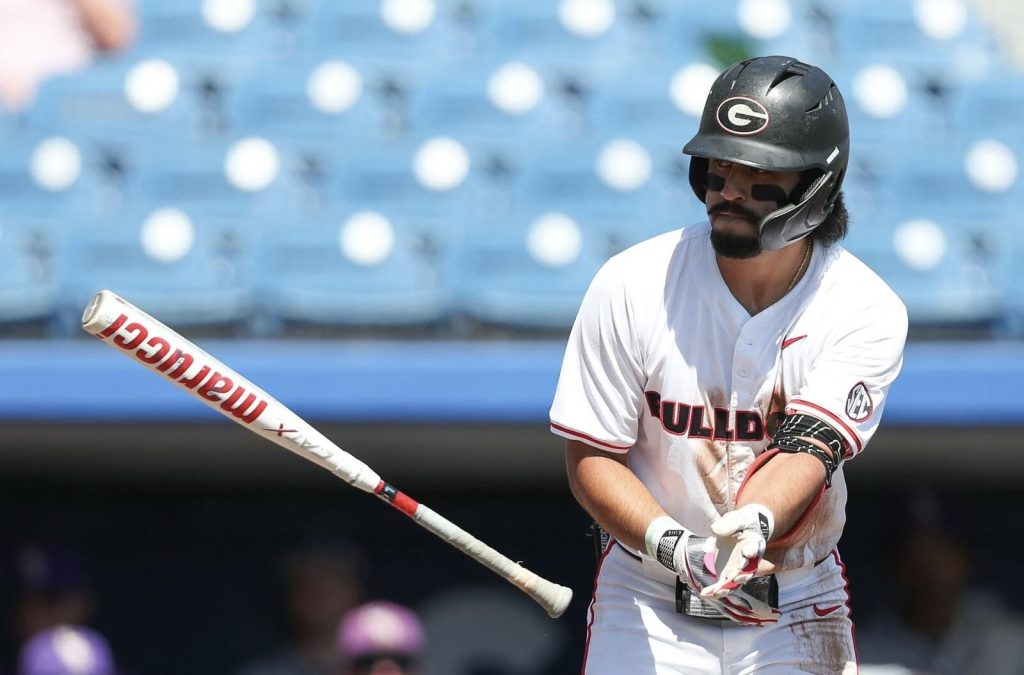Link to Article in The Red & Black
By Olivia Sayer

Georgia senior Sebastian Murillo (2) walks during the first round of the 2024 SEC Baseball Tournament between LSU and Georgia at the Hoover Met Stadium in Hoover, Alabama, on Tuesday, May 21, 2024. Georgia lost 9-1. (Photo/Mady Mertens; MadyMertensPhotography)
Georgia baseball was riding high into the 2024 SEC Tournament. Despite drawing the defending College World Series champion LSU in the first round, the Bulldogs’ season had many projecting them to win at least a couple of games.
Instead, after just nine innings of play, Georgia is headed back to Athens after suffering a 9-1 loss on day one of the Tournament. While the Bulldogs continued to struggle on the mound, it was the performance of the bats that shocked the eyes of many looking on.
Entering the Tournament, Georgia was second in the SEC in batting average, home runs, total bases, slugging percentage, RBI and runs scored. The Bulldogs’ 140 long balls was a school record, and the Georgia offense did not show any signs of slowing down.
That projection changed after the Bulldogs saw LSU starter Gage Jump Tuesday morning.
Playing a must-win game, the Tigers threw one of their top arms, despite him pitching on four days of rest. In seven innings, Jump limited the dynamic Bulldog offense to just one-run on four hits. In his performance, Jump was assisted by two things— the ballpark and his defense.
Hoover Met Stadium does not share the same short porch Georgia is accustomed to at Foley Field, as its right field wall sits 26 feet deeper than the Bulldogs’ home park. This discrepancy was evident Tuesday, as there were multiple fiyouts that would have been home runs in most college ballparks, including Georgia’s.
The first was off the bat of Kolby Branch, who sent a pitch about 403-feet to deep center field in the bottom of the fifth inning. The only problem was that the outfield wall in center field is 405 feet.
An inning later, Dylan Goldstein entered as a pinch-hitter for Paul Toetz. With Georgia trailing by four, Goldstein smashed a pitch to right-field, but it was just short of letting him round the bases. LSU’s right-fielder made an impressive catch against the yellow padding on the top of the wall to rob Goldstein of an extra-base hit.
Of the 54 outs in the game, 23 were recorded by a flyout. In the loss, Georgia was held homerless for just the seventh time this season. On the other side, LSU only hit one long ball, and it occurred in the top of the ninth inning.
The Bulldogs have not had success in Hoover Met Stadium, as they got eliminated in the first round of the Tournament for the third-straight year. Prior to this year’s matchup, Georgia did not hit in the park during its practice on Monday.
According to head coach Wes Johnson, the Bulldogs practiced from around 9 a.m. to 11 a.m. Monday morning in Athens, before getting on the bus to Hoover. Once they arrived, the players did some light work on the field.
“We hit for about two hours in Athens before we came,” Johnson said Monday evening. “I just wanted to get us back out here and move around after a four-hour bus ride. So, we didn’t hit. We just took some ground balls, moved around. They’re 18 to 23 year-old men. They’re not going to go back and go to bed, so I just tried to get them a little more tired, so they can go to sleep.”
Georgia’s offense was also plagued by a solid LSU defensive outing, as the Tigers’ glovework stopped multiple potential Bulldog rallies.
In the bottom of the third, LSU’s center fielder made a sliding catch to rob Charlie Condon of a knock. The catch played a part in snapping Condon’s 24-game hitting streak and kept him from crossing first base the entire game. A batter later, the Tigers’ third baseman made a barehanded throw across the diamond to rob Tre Phelps of an infield single.
In the game, Georgia struck out eight times. Of those eight strikeouts, six were swinging. One occurred on a 3-0 count, while at least two came with runners on base. All but two of the pitches batters chased for the final strike appeared to be outside of the zone.
“You watch big league baseball, and a guy comes up who’s got really good stuff,” Johnson said after a game against Florida that saw Georgia strikeout swinging seven times. “And all of a sudden, whoever you think’s got a very low strikeout rate, and you see him against somebody who’s really got a lot of movement. When you see good hitters who know the strike zone start to chase, then flags should come up immediately.”
The Bulldogs now await their NCAA Tournament seeding, which will be revealed Monday at 12 p.m. on an ESPN2 selection show. For now, Georgia will spend its time looking for ways to improve.
“The good news is, we’ve got seven, eight, nine, 10 days to work on it,” Johnson said.